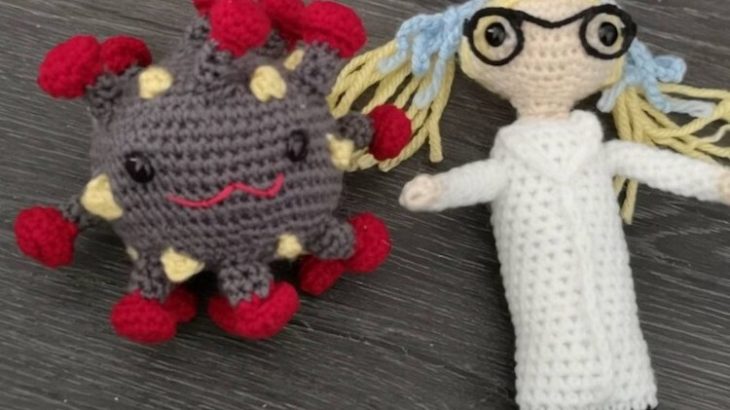You might think of crochet as just a pleasant hobby for passing long winter evenings during an endless pandemic. But in the right hands, crochet can also be a wonderful way to communicate science.
Not only is Dr. Tahani Baakdhah a medical doctor with a Ph.D. in neurobiology, but she is also an entrepreneur and an expert at sharing science through crochet. Despite her busy life, she was kind enough to share her thoughts about science crochet.

Dr. Tahani Baakdhah with some of her work. Photo by Tahani Baakdhah, used with permission
The word crochet comes from the French term for “small hook,” referring to the tool used to loop the yarn together. Crochet and knitting share many characteristics, and Baakdhah is not one to split hairs or yarns. She says, “Both can be used to show creativity in explaining basic and complex science concepts.”
Baakdhah admits that she was not immediately hooked the first time she tried her hand at crochet. Back in an elementary school art club in Saudi Arabia, she preferred to express herself through drawing and painting. Nonetheless, art in one form or another has always been important to her. Alongside art, Baakdhah was also interested in science and went on to study medicine at King Abdulaziz University. Baakdhah did not take up her crochet hook again for many years, until she had her own children. On Instagram, she noticed cute, crocheted toys, commonly known by the Japanese term amigurumi. By studying YouTube videos, she figured out how to make some for her small children. She soon set up her own Etsy shop, PurpleLilacAmigurumi, and started selling amigurumi herself. The shop still goes by the same name, though the focus is now on science crochet.
A few years later, organizers of a science festival in Toronto invited Baakdhah to teach a crochet workshop called “Knit-a-Neuron.” This was a project inspired by two neuroscientists in Britain, Dr. Anne Cooke, a knitter, and Dr. Helen Featherstone, a crocheter. Baakdhah was in graduate school at the time and took the hashtag #CrochetYourPhd seriously by developing crochet models of her doctoral research on retinal stem cells. She even published a book, Science Crochet: Building the Retina, which features the one-of-a-kind patterns she developed.

Crochet models of retinal stem cell research. Photo by Tahani Baakdhah, used with permission
Baakdhah says that she made the book for science fans everywhere, as a creative gift or a model for teaching. She exhibited her crocheted retinal neurons at the University of Toronto as part of a Narrating Neuroscience event. She has enjoyed other events in which she used the fabric models to explain how eyes work. “Understanding basic anatomy and physiology of vision helped me a lot in appreciating art in all forms.” Creating art has helped her develop the habit of paying attention to the details of things both “under the microscope or in real life.”
Baakdhah completed her doctorate on applying retinal stem cells to repair retinal degeneration. Since then, she has been expanding her creative repertoire. “I get ideas from trending science topics, a research project I am currently working on in the lab, or from our lab journal club,” she says. “I start creating and testing the pattern before sharing it with my social media followers or on my Etsy shop.” She appreciates how her crochet work has given her the opportunity to learn about other fields of science. She meticulously researches subjects to ensure her crocheted models accurately depict morphology.

Crocheted COVID-19 virus. Photo by Tahani Baakdhah, used with permission
With the outbreak of COVID-19, Baakdhah created a crochet model of the SARS-Cov-2 virus. After posting a photo of it on social media, she received many requests and added it to her shop. However, in an effort to protect customers from buying into fraudulent remedies or tasteless humour items, Etsy banned all items labelled “corona” or “COVID-19,” including Baakdhah’s educational materials. She carries on undaunted, still listing these products, but without those terms in the descriptions.
Science crochet might seem to be more like a Gordian knot, but Baakdhah says “Nothing is difficult if you give it a try!” She suggests beginning with online videos to learn basic stitches and simple patterns. Once you get comfortable with the techniques, you can apply your creativity to science communication and beyond.
~
Feature image: Science crochet. Photo by Tahani Baakdhah, used with permission.




